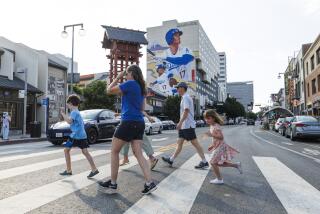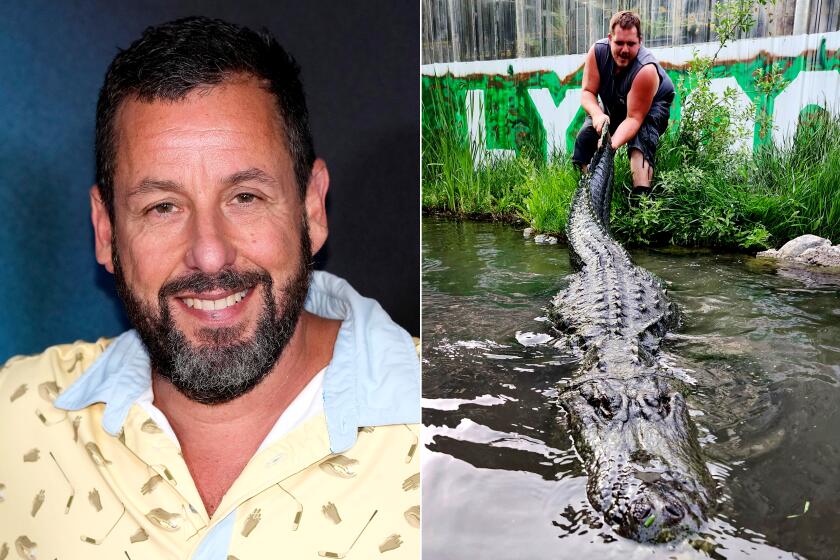In ‘Spy,’ the clothes make Melissa McCarthy’s undercover agent
- Share via
Writer-director Paul Feig always wanted to make a spy film, but he said he knew no one was going to let him make a James Bond or Jason Bourne movie. So he wrote his own.
“I didn’t want to make it a spoof or a parody,” he explained. “So I thought to myself, ‘How do you make “Casino Royale” funny?’”
Feig found the answer to his question in casting Melissa McCarthy as the lead of “Spy,” which opens Friday. She allowed him to pull off what he calls “the comedy of being undervalued,” at the center of which are multiple disguises for her character, all keyed to witty and surprising costumes designed by Christine Bieselin Clark.
ALSO: Meet the four faces of Melissa McCarthy in ‘Spy’
Appearances in spy movies are mostly meant to deceive. But in “Spy,” McCarthy’s disguises serve multiple purposes and are meant to make you think about her character.
McCarthy plays Susan Cooper, a woman one wouldn’t peg as a secret agent. Relegated behind a desk, her simple attire and self-deprecating attitude give the perception that desk work is what best suits her. Much of the film’s comedy centers around these looks — and Cooper’s distaste for most of them.
“Movie spies are going to be glamorous, but in real life you have to be invisible,” Feig said. “It was fun going with this dumpy person and [figuring out] how far can we take the dumpiness.”
When Cooper gets the chance to go in the field, the quirky identities she takes on prove her worth. At the center of these personas are the ensembles McCarthy dons to drive the point home. Bieselin Clark, who also worked on “Ender’s Game,” “300” and “Watchmen,” said the looks were integral to bringing Feig’s words to life.
INDIE FOCUS: Sign up for our weekly movies newsletter
“In the beginning, it is a comedy and fun to read, but for me it was always about who are these characters, their intentions and how do we convey them as real people,” Bieselin Clark said. “Then we pushed things as far in the opposite direction as we could.”
In collaboration with McCarthy, and using “bread crumbs” Feig left in the script, Bieselin Clark (along with Linda Flowers, who did the wigs) fashioned four distinct looks that in turn prompted Feig and the cast to add a number of comedic barbs throughout the film.
The base costume for McCarthy’s character is the starting point of a drab-to-fab transformation. “She had to be kind of simple, but we didn’t want her to seem unattractive and dowdy,” Bieselin Clark said.
That changed on Cooper’s first field assignment when she went undercover as Carol Jenkins, a Midwestern mother of three who pairs suede Native American vests with gaudy skirts. McCarthy was eager to “go as far as we can in making things look awful,” Bieselin Clark said.
“She’s not afraid and the comedy of it is that it’s so bad you can’t possibly believe they’ve done that [to her],” she continued.
Penny Morgan, McCarthy’s second persona, was perhaps the funniest, and easiest, look to put together. A “Middle America, older gal who dresses for comfort,” likes decoupage and owns 10 cats, Morgan wore a bright pink sweatsuit and cat-faced sweater (which Feig had originally written into the script).
Bieselin Clark designed McCarthy’s final looks, in which Cooper sexes it up a bit and dons clothing one would actually expect of a CIA agent. Bieselin Clark worked hard to balance an edgy and athletic look with a classic spy feel inspired by 1950s cigarette pants, she said.
Wigs were also important to conveying the intended messages. In fact, Bieselin Clark said, many of the wigs inspired entire looks.
The goal of all of the film’s wardrobe in the end was to stay authentic to the genre of spy movies.
“We had to figure out how do you raise the bar and keep the standard,” Bieselin Clark said. “This is our 007. It just happens to be funny.”
Feig hopes that through Bieselin Clark’s realistic costumes, the characters he’s written and the comedic prowess of the powerhouse cast, audiences will respond in a different way than they usually do to a spy movie.
“They’re so much like a spectacle,” he said. “We put a real person in the middle of this situation. I want you to have a completely believable experience.”
More to Read
Only good movies
Get the Indie Focus newsletter, Mark Olsen's weekly guide to the world of cinema.
You may occasionally receive promotional content from the Los Angeles Times.










